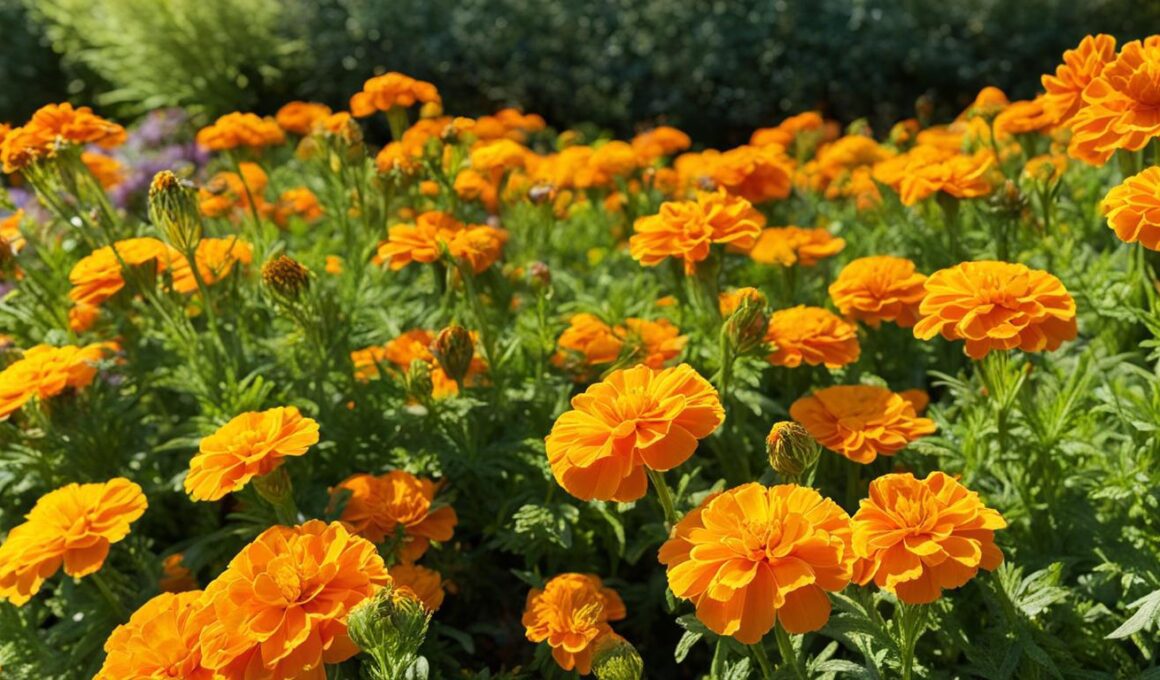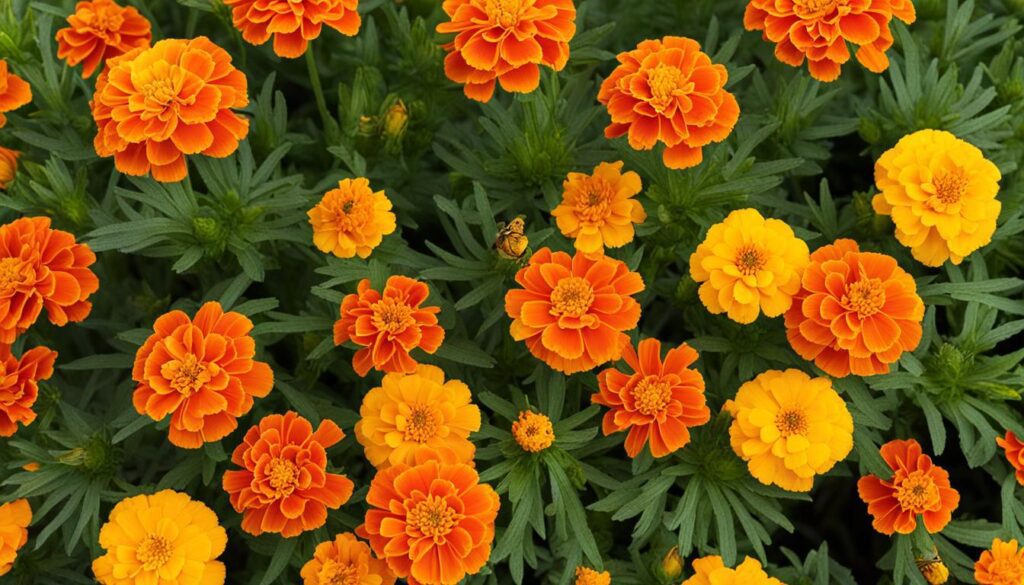Marigolds are an essential addition to any garden. They are versatile and well-suited to ornamental landscaping, container growing, and vegetable gardens. With a wide variety of colors and types available, marigolds can add a vibrant pop of color to your garden. They are low-maintenance, hardy flowers that can withstand temperature fluctuations and bloom well into the fall. Marigolds are also drought tolerant, making them a great choice for areas with dry climates. They can be easily grown from seed and often self-seed, providing new flowers each year. In addition, marigolds attract pollinators like bees and butterflies, which are essential for vegetable growth. They can also help deter pests and control nematode populations in the soil.
Key Takeaways:
- Marigolds are versatile, low-maintenance flowers that can transform your garden with vibrant colors.
- They attract pollinators like bees and butterflies, which are essential for vegetable growth.
- Marigolds can help deter pests and control nematode populations in the soil.
- They are drought tolerant and can withstand temperature fluctuations, making them suitable for various climates.
- Marigolds are easy to grow from seed and often self-seed, providing new flowers each year.
Hardy Flowers for Low-Maintenance Gardening
When it comes to creating a low-maintenance garden, choosing hardy flowers is essential. These resilient plants can withstand various weather conditions, including drought and temperature fluctuations, making them perfect for busy gardeners or those with limited time to dedicate to gardening. One such hardy flower that ticks all the boxes is the marigold.
Marigolds are known for their ability to thrive in challenging environments. They are drought tolerant, meaning they can survive with minimal watering, making them ideal for areas with limited rainfall or for gardeners who want to conserve water. Additionally, marigolds are easy to grow from seed, and some varieties even self-seed, providing a continuous bloom year after year.
Whether you have a large garden or are limited to a small balcony, marigolds can add a pop of color to any space. They are particularly well-suited to container gardening, allowing you to enjoy their vibrant blooms even if you don’t have a traditional garden bed. With their low-maintenance nature and ability to tolerate various growing conditions, marigolds are a must-have for any gardener looking to create a beautiful and hassle-free garden.
The Resilience of Marigolds
Marigolds are known for their resilience and ability to thrive in challenging conditions. Their hardiness makes them a reliable choice for low-maintenance gardening. Here are some key features that make marigolds such resilient plants:
- Drought Tolerance: Marigolds have a moderate to high tolerance for dry conditions and can survive with minimal watering.
- Temperature Resilience: These flowers can handle temperature fluctuations, thriving in both hot summers and cooler fall months.
- Self-Seeding: Some marigold varieties have the ability to self-seed, meaning they will continue to grow and bloom without the need for replanting.
- Low-Maintenance Growing: Marigolds are easy to grow from seeds, making them a hassle-free choice for gardeners of all experience levels.
Container Gardening with Marigolds
Container gardening offers a convenient way to enjoy the beauty of marigolds in small spaces. Here are a few tips to get you started:
- Choose the Right Containers: Opt for containers with good drainage to prevent waterlogging and root rot.
- Select Appropriate Soil: Use well-draining potting soil to ensure proper moisture retention without waterlogging the roots.
- Provide Adequate Sunlight: Marigolds thrive in full sun, so place your containers in a spot that receives at least six hours of direct sunlight per day.
- Water Consistently: While marigolds are drought tolerant, it’s important to water them consistently to promote healthy growth and vibrant blooms.
By following these simple steps, you can create a stunning container garden filled with the vibrant hues of marigolds, enhancing any outdoor space.
Table: Comparing Hardy Flowers for Low-Maintenance Gardening
| Flower | Drought Tolerance | Temperature Resilience | Self-Seeding | Low-Maintenance Growing |
|---|---|---|---|---|
| Marigolds | High | Excellent | Some varieties | Yes |
| Petunias | Moderate | Good | No | Yes |
| Zinnias | Moderate | Good | No | Yes |
| Salvias | High | Excellent | No | Yes |
Attracting Pollinators and Beneficial Insects
One of the greatest benefits of planting marigolds in your garden is their ability to attract pollinators like bees and butterflies. These important insects play a crucial role in the growth and reproduction of many plants, including vegetables. By planting marigolds with open center flowers, such as Bambino, Golden Guardian, Legion of Honor, and Lemon Gems, you can provide an easily accessible food source for these pollinators. The vibrant colors and sweet nectar of marigolds act as a magnet, inviting bees and butterflies to visit your garden.
But attracting pollinators is not the only advantage of having marigolds in your garden. These flowers also attract beneficial insects that can help control pest populations. Ladybugs, lacewings, hoverflies, and parasitic mini-wasps are just a few examples of the beneficial insects that are drawn to marigolds. These insects feed on pests like aphids, whiteflies, and cabbage worms, which can damage your plants. By providing a habitat that attracts beneficial insects, marigolds contribute to a natural and sustainable approach to pest control in your garden.
Marigolds are like a welcome sign for pollinators and beneficial insects in your garden. Not only do they provide food and shelter, but they also create a diverse and balanced ecosystem that supports the health and growth of your plants.
By including marigolds in your garden, you enhance the overall biodiversity and ecological balance. The presence of pollinators and beneficial insects not only improves plant pollination and control of pests but also contributes to the natural beauty and harmony of your outdoor space. So, make sure to plant marigolds in your garden to attract pollinators, control pest populations, and create an inviting haven for nature’s helpers.
Table: Marigold Varieties for Attracting Pollinators
| Variety | Color | Flower Type | Attracts |
|---|---|---|---|
| Bambino | Yellow, Orange | Double | Bees, Butterflies |
| Golden Guardian | Yellow | Single | Bees, Butterflies |
| Legion of Honor | Golden Yellow | Single | Bees, Butterflies |
| Lemon Gems | Lemon Yellow | Double | Bees, Butterflies |
Pest Deterrent and Nematode Control
When it comes to protecting your garden from pests, marigolds are a natural deterrent. These colorful flowers have been found to repel whiteflies and cabbage worms, pests that can wreak havoc on your plants. The strong scent emitted by French marigold plants contains a terpene that acts as a natural repellent, keeping these pests at bay. By planting marigolds strategically throughout your garden, you can create a barrier that protects your plants from infestations.
In addition to repelling pests, marigolds also play a role in nematode control. Nematodes are microscopic worms that live in the soil and can harm the roots of your plants, leading to stunted growth and poor yields. However, marigolds produce a chemical compound called alpha-terthienyl, which is toxic to nematodes. This compound helps to reduce the population of these harmful pests in the soil, ensuring the overall health and vitality of your plants.
| Pest | Marigold Variety | Effectiveness |
|---|---|---|
| Whiteflies | French Marigolds | Highly effective |
| Cabbage Worms | African Marigolds | Effective |
By incorporating marigolds into your garden, you can naturally deter pests and protect the growth of your plants. Whether it’s repelling whiteflies or controlling nematodes, marigolds offer a simple and effective solution for maintaining a healthy garden.
Edible Flowers and Companion Planting
Marigolds are not just beautiful flowers; they are also edible and can add both color and flavor to your dishes. The petals of marigolds can be used in salads, as decoration for baked goods, or even to make teas and jellies. Adding marigold petals to your culinary creations can provide a unique touch and enhance the visual appeal of your meals.
In addition to their culinary uses, marigolds are also beneficial as companion plants in the garden. Companion planting is the practice of planting certain species together to enhance each other’s growth and deter pests. Marigolds are great companion plants for a variety of vegetables. They can help repel pests like aphids, whiteflies, and cabbage worms, allowing your vegetable garden to thrive. By planting marigolds alongside your vegetables, you can create a natural pest control system and reduce the need for chemical pesticides.
Companion planting marigolds can also improve soil health and nutrient availability for your crops. Certain marigold varieties, such as French marigolds (Tagetes patula) and African marigolds (Tagetes erecta), have deep roots that can break up compacted soil and improve its structure. This can benefit neighboring plants by increasing water infiltration and nutrient absorption. Additionally, marigolds can be used in crop rotation systems to help reduce soil-borne diseases and maintain soil fertility.
When selecting marigold varieties for companion planting, consider their height and growth habit. Some marigold varieties, such as the compact French marigolds, are better suited for small-scale gardens and container planting. Taller varieties, like the African marigolds, can be used as background plants in larger garden beds. Mixing different marigold varieties can create a visually appealing and diverse garden.
Table: Marigold Varieties for Companion Planting
| Marigold Variety | Height | Growth Habit |
|---|---|---|
| French Marigold (Tagetes patula) | 6-12 inches | Compact, bushy |
| African Marigold (Tagetes erecta) | 1-3 feet | Tall, upright |
| Lemon Gem Marigold (Tagetes tenuifolia) | 6-12 inches | Compact, feathery foliage |
| Pacifica Marigold (Tagetes erecta) | 1-2 feet | Medium height, double flowers |
Source: Self-authored
By incorporating marigolds into your garden as edible flowers and companion plants, you can create a beautiful and productive space. Enjoy the vibrant blooms of marigolds while also benefiting from their pest-repelling properties and improved soil health. Experiment with different marigold varieties and companion planting arrangements to find what works best for your garden. Happy gardening!
What Are the Benefits of Having Marigolds in Your Garden?
Growing marigolds in gardens brings multiple benefits. These vibrant flowers not only repel pests like mosquitoes and aphids but also attract beneficial insects like butterflies and bees. Their strong scent is known to deter nematodes in the soil, making them a valuable addition to any garden.
Conclusion
Marigolds in the garden offer a multitude of benefits that can enhance your gardening experience. These vibrant flowers not only add a beautiful splash of color, but they also attract important pollinators like bees and butterflies, ensuring the successful growth of your vegetables. Additionally, marigolds act as a natural pest control solution, deterring harmful pests and attracting beneficial insects that keep your garden healthy.
Another notable advantage of marigolds is their versatility in the kitchen. The edible petals of marigolds can be used to enhance salads, baked goods, teas, and jellies, adding both flavor and visual appeal to your dishes.
Furthermore, marigolds play a significant role in nematode control, protecting your plants from these soil-dwelling parasites. By incorporating marigolds into your garden, you can help maintain the overall health and productivity of your plants.
In conclusion, including marigolds in your garden provides a multitude of benefits, from attracting pollinators and controlling pests to adding edible flowers and combating nematodes. Embrace the beauty and advantages of marigolds in your garden today!
FAQ
Are marigolds easy to grow?
Yes, marigolds are easy to grow from seed and some varieties can even self-seed, making them a low-maintenance choice for any gardener.
Can marigolds attract pollinators?
Yes, marigolds can attract pollinators like bees and butterflies to your garden, which is essential for vegetable growth.
Do marigolds deter pests?
While marigolds may not repel all pests, they have been found to deter whiteflies and attract beneficial insects that can help control pest populations.
Can marigolds control nematodes?
Yes, planting marigolds can help control nematode populations, which are soil-dwelling parasites that can negatively impact plant growth.
Can marigold petals be eaten?
Yes, marigold petals are edible and can be added to salads, used as decoration for baked goods, and even used to make teas and jellies.
Are marigolds suitable for companion planting?
Yes, marigolds are beneficial as companion plants. They can be planted alongside vegetables to repel pests, attract beneficial insects, and improve the overall health of the garden.











